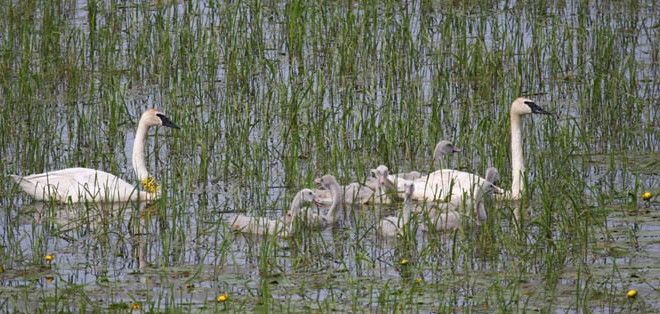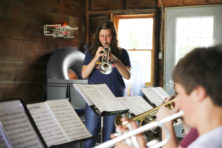Trumpeter Swan Numbers Soar
- Share
- Tweet
- Pin
- Share

The number of trumpeter swans in Wisconsin has zoomed from zero to nearly 4,700 a generation after the Department of Natural Resources and partners launched recovery efforts, national surveys results show.
Population estimates from aerial surveys of interior North America peg Wisconsin’s number of adult and “sub-adult” trumpeter swans at 4,695 birds in 2015, more than six times as many as the 672 estimated during the last survey five years ago, and up from 24 in 1990.
“Working with many partners, Wisconsin DNR over the past quarter century has used the tax check off and other funding sources to restore a healthy and growing population of trumpeter swans that is part of a regional resurgence,” says Sumner Matteson, an avian ecologist for the DNR Natural Heritage Conservation program and the biologist who collected the first egg from Alaska in 1989 that launched the Wisconsin recovery program. “It’s gratifying for all the partners involved that we’ve had this success.”
Matteson said had it not been for the support and interest of the public in restoring species through the tax check off, private donations and federal grants, the recovery of trumpeter swans in Wisconsin would not have happened.
“This has been a model of success between the public and private sector to restore part of our heritage once lost,” he says. “It’s also a good example of persistence and patience, which is especially important with the restoration of endangered birds.”
Market hunting and demand for the feathers of trumpeter swans brought these birds, one of North America’s largest, to near elimination from Wisconsin and other upper Midwest states by the 1880s.
Wisconsin put the species on the state’s endangered species list in the 1980s, which made it illegal to kill, transport, possess, process or sell them, and launched a recovery effort that collected eggs from the wilds of Alaska, hatched them at the Milwaukee Zoo, and reared the young in the wild using decoys, and in captivity, before releasing them.
Scores of organizations, businesses and private individuals worked to carry out the recovery effort with state wildlife managers, technicians, research scientists, University of Wisconsin-Madison wildlife ecologists, and U.S. Fish & Wildlife Service staff. Two of the private partners, Mary and Terry Kohler of Sheboygan, were honored in 2012 by the state Natural Resources Board for their role in helping transport the eggs used in the recovery program from Alaska, and for their financial help.
The Natural Resources Foundation of Wisconsin helped secure much needed funding, while the Endangered Resources Fund and the bird’s protected status under the endangered species law both significantly aided outreach efforts and helped to fund Wisconsin’s monitoring efforts.
Trumpeter swans reached the recovery goal early – more than doubling the 20 breeding pairs hoped for by 2000 – and Wisconsin removed it from the endangered species list in 2009. Trumpeter swans remain protected under the federal Migratory Bird Treaty, which celebrates its centennial this year.
Annual DNR surveys to monitor trumpeter swan nests and to band new hatchlings ended in 2012. The national aerial survey, conducted once every five years, is now the main way Wisconsin keeps tabs on trumpeters. This survey counts all the white trumpeter swans seen along transect routes, not just the number of adults actively sitting on nests, so the numbers are much higher in the aerial surveys than the nesting surveys.
The 2015 North American survey was conducted in Wisconsin in mid-May by DNR biologists, research scientists and pilots who flew along established routes to count ducks and other waterfowl, with special additional routes established to focus only on adult and “sub-adult” swans. Sub-adults or nonbreeding swans are white like the adults.
Other states’ recovery efforts have been working as well, particularly in Minnesota, which launched the first Midwestern efforts, and where the 2015 surveys estimated 17,021 birds. Together, Minnesota, Wisconsin and Michigan (3,021 birds) comprise most of the 27,000 birds in what is known as the Interior Trumpeter Swan Population, which is comprised largely of restoration flocks. For management purposes, there are considered to be two other trumpeter swan populations: the Pacific Coast Population and the Rocky Mountain Population.

